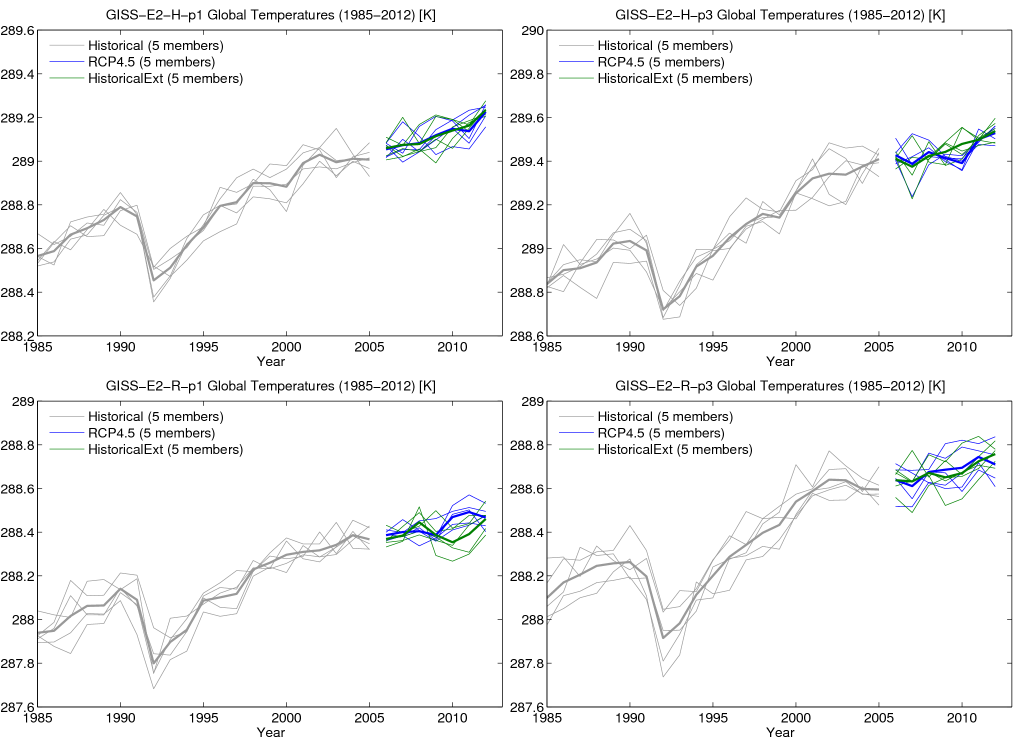The recent global temperature hiatus has been explained by the IPCC AR5 as partly due to natural radiative forcings (solar & volcanic effects) and internal variability. Recently, other effects such as CFCs and biases in the observational coverage have also been suggested, as well as continuing uncertainty about the regional effects of aerosol forcings. When comparing simulations and observations, the CMIP5 simulations tend to use projected forcings rather than observed forcings after 2005. But what effect does this have?
The figure below compares global temperatures in four versions of the NASA GISS GCM. There are 5 simulations with historical forcings up to 2005 (grey), 5 simulations using RCP4.5 from 2006-2012, and 5 simulations using historicalExt forcings from 2006-2012. The historicalExt forcings use observed greenhouse gas (GHG) concentrations, solar cycle and volcanic aerosols, but use the aerosol emissions from RCP4.5. The observed GHG concentrations are higher than in the reference RCP4.5 scenario.
Note that the differences between the mean of the simulations (thick lines) are small with no clear differences. Perhaps this is unsurprising given the relatively small ensemble size and small possible effects. However, this suggests that the higher GHG concentrations may help cancel out the negative forcing from the natural factors somewhat, in this model. It would be great to see other groups perform similar experiments (with multiple ensemble members), but to my knowledge only NASA GISS have done this so far.

We’ve actually done a lot more. These runs used an early estimate of 2006-2012 volcanoes, but there are further updates that have since been made (and more to come). The solar cycle was also updated. There are still a lot of issues related to the underestimate of Asian aerosol sources (even before 2000). Watch this space.
Excellent – thanks – I look forward to seeing the new results.
cheers,
Ed.
It would be great to see other groups perform similar experiments, but to my knowledge only NASA GISS have done this so far.
Not sure what you mean by this? Several groups have historicalExt simulation data available at PCMDI. Is there something specific different about the GISS simulations or do you mean the experiments with alternative model physics configurations?
It would be somewhat surprising if a plausible difference between the historicalExt and RCP scenarios over 2006 and 2012 indicated a dominant forced response explanation. If forcing error is part of the explanation I think you’d need to go back two or three decades and consider, for example, whether underestimates of Asian (and African and South American) aerosol emissions/concentrations over the whole period might have caused 25-30 year model trends to be too large. Smaller forced response trends due to enhanced aerosol-induced cooling would enable internal variability to enact a greater influence, making “pauses” far more likely.
Thanks Paul.
Yes, there are a few other models with some historicalExt simulations but all the others (except HadGEM2) only have 1 or 2 ensemble members which is not enough to be confident about any differences seen. And, the HadGEM2 simulations are not using updated forcings, but just extending until present under an RCP. [Will edit post for clarity.]
Agreed that there are larger uncertainties in the past with aerosols (see recent Carslaw et al paper in Nature too), but some of the recent pause is likely due to natural forcings (solar & volcanic) which are not updated in the standard post-2005 simulations. I was quickly testing whether this was possible to see.
cheers,
Ed.